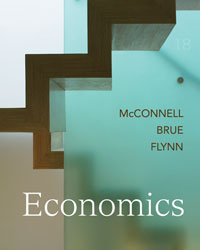Economics (McConnell), 18th EditionChapter 5:
The United States in the Global EconomyWorked Problems <a onClick="window.open('/olcweb/cgi/pluginpop.cgi?it=jpg::::/sites/dl/free/0025694212/384254/wp_icon_20.jpg','popWin', 'width=NaN,height=NaN,resizable,scrollbars');" href="#"><img valign="absmiddle" height="16" width="16" border="0" src="/olcweb/styles/shared/linkicons/image.gif"> (19.0K)</a>
Problem 5.1 - Gains from specialization <a onClick="window.open('/olcweb/cgi/pluginpop.cgi?it=jpg::::/sites/dl/free/0025694212/384254/wp_icon_20.jpg','popWin', 'width=NaN,height=NaN,resizable,scrollbars');" href="#"><img valign="absmiddle" height="16" width="16" border="0" src="/olcweb/styles/shared/linkicons/image.gif"> (19.0K)</a>
Problem 5.1 - Gains from specialization
Problem: The production possibilities tables for Malaysia and the United States are shown in the tables below. Before specialization and trade, Malaysia's optimal product mix is given by alternative C while optimal production in the U.S. is alternative J. | | Malaysia Production Possibilities | | Product | A | B | C | D | E | | Clothing | 20 | 15 | 10 | 5 | 0 | | Grain | 0 | 3 | 6 | 9 | 12 | | | | | | | | | | U.S. Production Possibilities | | Product | G | H | I | J | K | | Clothing | 32 | 24 | 16 | 8 | 0 | | Grain | 0 | 10 | 20 | 30 | 40 |
- What is Malaysia's marginal opportunity cost of clothing? Of grain?
- What is the U.S. marginal opportunity cost of clothing? Of grain?
- Should these two countries specialize? If so, in what products should they specialize?
- What is the total gain in production that could be achieved through specialization?
- What are the limits on the terms of trade between the two nations?
- Following specialization, suppose Malaysia exports 10 units of clothing to the U.S. in exchange for 10 units of grain. What are the gains from trade for each country?
| Answer: - In Malaysia, 5 more units of clothing can be produced by giving up 3 units of grain. The opportunity cost of clothing is then 3/5 = 0.6 units of grain. The opportunity cost of grain is 5/3 = 1.67 units of clothing.
- In the U.S., 8 additional units of clothing can be produced by giving up 10 units of grain. The opportunity cost of clothing is then 10/8 = 1.25 units of grain. The opportunity cost of grain is 8/10 = 0.8 units of clothing.
- Malaysia has a lower opportunity cost of clothing while the U.S. has a lower opportunity cost of grain. Malaysia should specialize in clothing and the U.S. in grain.
- Prior to specialization, the two countries’ combined clothing production was 18 (10 in Malaysia and 8 in the U.S.). Total grain production was 36 (6 + 30). With complete specialization, Malaysia will produce 20 units of clothing (a gain of 2 over the previous combined total) and the U.S. 40 units of grain (a gain of 4 units.)
- The terms of trade can vary anywhere between the pre-trade opportunity cost ratios. That is, anywhere between 1 unit of clothing for 0.6 units of grain and 1 unit of clothing for 1.25 units of grain.
- Following trade, Malaysia would have 10 units of clothing (production of 20 minus exports of 10) and 10 units of grain. Compared to its pre-trade choice at C, it has gained 4 units of grain. The U.S. would obtain 10 units of clothing and retain 30 units of grain (production of 40 minus its exports of 10.) This is a gain of 2 units of clothing compared to its pre-trade position.
|
 | 




